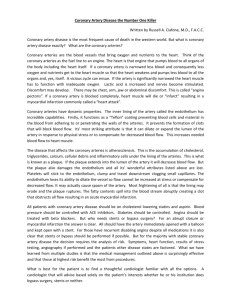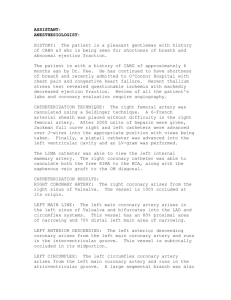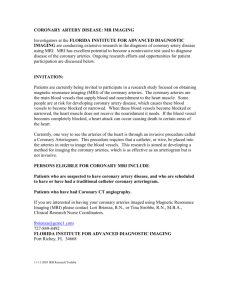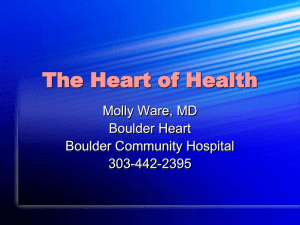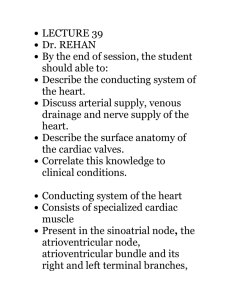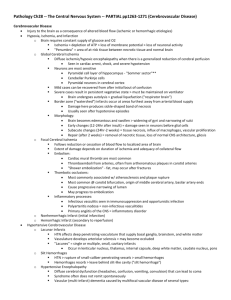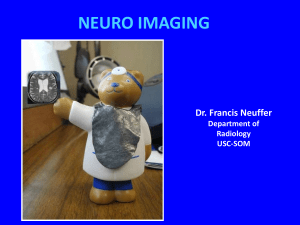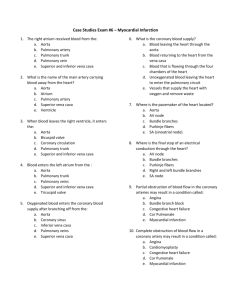Sudden Natural Deaths
advertisement
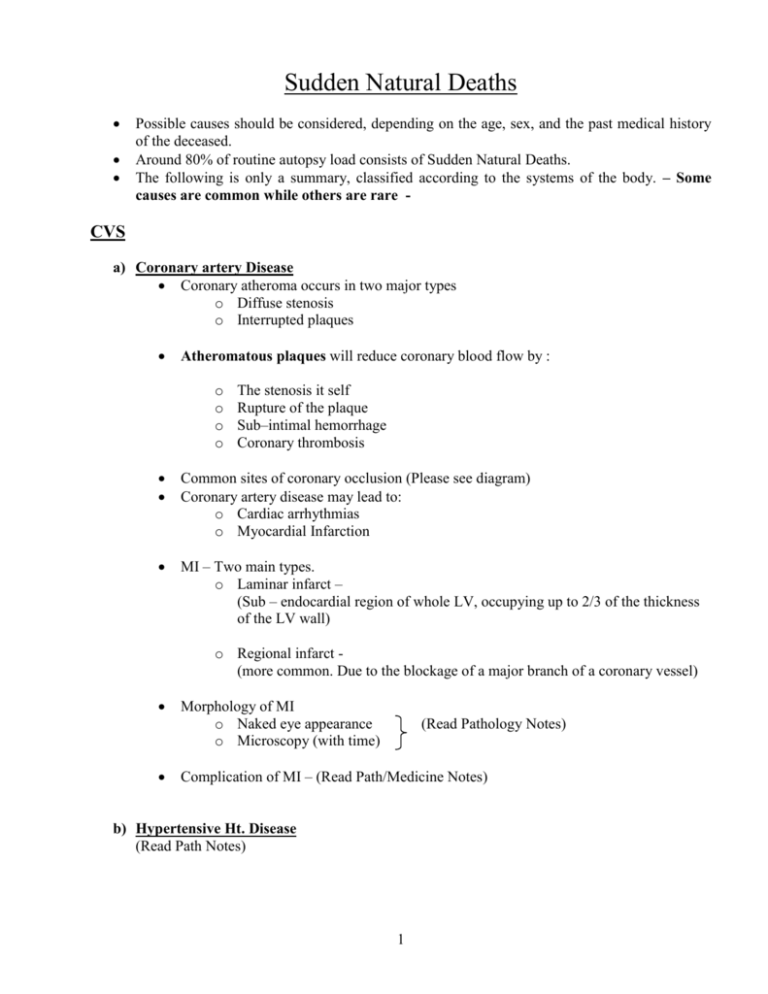
Sudden Natural Deaths Possible causes should be considered, depending on the age, sex, and the past medical history of the deceased. Around 80% of routine autopsy load consists of Sudden Natural Deaths. The following is only a summary, classified according to the systems of the body. – Some causes are common while others are rare - CVS a) Coronary artery Disease Coronary atheroma occurs in two major types o Diffuse stenosis o Interrupted plaques Atheromatous plaques will reduce coronary blood flow by : o o o o The stenosis it self Rupture of the plaque Sub–intimal hemorrhage Coronary thrombosis Common sites of coronary occlusion (Please see diagram) Coronary artery disease may lead to: o Cardiac arrhythmias o Myocardial Infarction MI – Two main types. o Laminar infarct – (Sub – endocardial region of whole LV, occupying up to 2/3 of the thickness of the LV wall) o Regional infarct (more common. Due to the blockage of a major branch of a coronary vessel) Morphology of MI o Naked eye appearance o Microscopy (with time) (Read Pathology Notes) Complication of MI – (Read Path/Medicine Notes) b) Hypertensive Ht. Disease (Read Path Notes) 1 c) Cardio myopathies Definition. - Read Types - HOCM - Dilated/Congestive CM - Restrictive CM HOCM – Read Path Histological appearance Dilated C.M. – Chronic Alcohol Abuse Post-Partum CM d) Coronary Artery anomalies * Coronary a. spasm (Prinzmetal Angina) * Muscular Bridging of C.A. * Acute C.A. dissection * Congenital anomalies i. Hypoplasia ii. Single coronary Artery iii. (L) CA arising from (R) sinus of valsalva and vice-versa etc. e) Valvular Ht Disease 1. 2. 3. MVP. (Floppy MV syndrome) Calcific aortic stenosis Endocarditis Infective Non-Infective f) Myocarditis Inflammation of the myocardium by infections, toxins, inflammatory conditions or connective tissue disorders - Infectious myocarditis(mainly viral) - Hypersensitivity - Giant cell myocarditis (granulomatous degeneration of Ht muscle due to auto-immune condition (SLE, thyrotoxicosis) g) Natural Diseases of Aorta Aneurysms Atheromatous Syphillitic Acute Aortic Dissection h) Cardiac Ion channelopathies Eg: Long QT syndrome, Brugada syndrome etc. 2 CNS a) Intra Cerebral Hemorrhage Causes: HTN Amyloid Angiopathy Av maltormations Tumors Bleeding Diathesis Drugs (cocaine, Amphytamine) Cerebral vasculitis The most common site External capsule (Artery of cerebral hemorrhage / charcots’ Artery) = Lenticulo-striate Br. Of middle cerebral artery Though the bleed is in the external capsule, the pressure effects commonly involve the internal capsule leading to a contra lateral stroke. Thus, the Basal ganglia and the capsular areas are most frequently affected by hypertensive hemorrhages. Can also occur in cerebellum, Thalamus, Mid Brain & Pons. Brain stem Pontine H’ges Read: How to differentiate a primary Brain system Hemorrhage from a secondary Brain system Hemorrhage. b) Cerebral Infarction 4 main causes: i. Large vessel Disease: Thrombosis or Embolism of large cerebral Arteries. ii. Small vessel Disease: - Arteriosclerosis of small Penetrating vessels with in Basal ganglia and pons. - Often due to HTN and DM. - Results in “Lacunar Infracts” iii. iv. Global Ischaemia. Venous Infarcts.(Very rare) A cerebral Infarct may appear as a small area of softening. may become cystic and brown in colors. c) Non Traumatic SAH o Ruptured Berry aneurysm. o Bleeding AV malformations. (Read notes on Head Injuries) (See Diagram of Circle of Willis) 3 Later, d) Epilepsy o Usually in young pts. o Most of the time A negative autopsy Bite wounds on tongue Sclerosis of Ammon’s Horn in Brain may be seen. e) Meningitis o In all age groups o Causative Organism (Read) o Meningococcalmia (with or without meningitis) can be rapidly fatal Waterhouse Friderichsen syn.(Petechaea, Purpura, B/L adrenal Hemorrhages) f) Primary Brain Tumors o Commonest (>50%) Astrocytoma glioblastoma category o Also, oligoderdroglimas, meningiomas, colloid Cysts, medulloblastomas etc. Even benign tumors can be rapidly fatal due to pressure effects. g) Hydrocephalus ed Volume of CSF in the cranial cavity. Internal H.C. External H.C. Communicating H.C. Non-communicating HC Compensatory HC Causes of Hydrocephalus – (Read) e.g.: Meningitis D.W.S. A.C.M. h) Psychiatric Disorders e.g. Schizophrenia 4 Resp. System: a. Pul. Thrombo Embolism DVT is encouraged by Trauma, Immobility, Debilitating illnesses, OCP, old age, Pregnancy, Surgery, Intercurrent diseases etc. o Ante-mortem thrombus vs. P.M. clot. (how to differentiate) AM Thrombus: Reddish grey Dull in luster. Firm and Not Friable (Can be handled without breaking) Side branches do not correspond to branches of pul. Artery. Surface is dull and contains wavy lines (of Zahn) due to deposition of fibrin and platelets. Often coiled. No “chicken fat on current gelly” appearance. b. Other pul. Emboli Amniotic fluid Air Bone marrow Fat etc. c. Bronchial Asthma. Hyper expanded, puffy, pale lungs with abundant mucous plugging of bronchii. d. Pneumonias e. Tuberculous Pneumonitis f. Acute Epiglotitis g. Massive Haemoptysis Causes: o Neoplasm or inflammatory cession of Naso pharynx o CA Bronchus eroding in to pul. Artery. o Cavitating TB o Cavitatory lung Abscess o Bronchiectasis o Aortic Aneurysm Bronchus Haemoptysis Oesophagus Haematemesis Erosion in to h. Spontaneous Pneumothorax Rupture of emphysematous bullae NB. – PM X Ray - PM technique of demonstration (read) 5 GIT i. Hematemesis oesophageal Varices (Portal HTN pre Hepatic Hepatic causes (read) Post Hepatic Mallory- Weiss syndrome ii. Massive upper GI Hemorrhage Eroded gastric/ duodenal ulcers. iii. Strangulated Hernia Bowel infarction iv. gangrene peritonitis sepsis Hemorrhagic Pancreatitis Mostly alcohol related Death is due to fluid and electrolyte imbalance Diabetes Mellitus Most reliable indicator for ante-mortem hyperglycaemia is vitreous humour glucose lavels (>200 mg/dl) v. Hepatic Disorders: Alcoholic liver Disease (-fatty change – advanced cirrhosis) Massive liver cell necrosis (Read causes) Adrenal Disorders: Pheochromocytoma Adrenal medullary tumor. (minor trauma, Surgery, abdominal examination etc Adrenal crisis cardiac stimulation death) Addison’s Disease (chronic adrenal insufficiency) sudden catecholamine release Splenic Disorders Splenic Rupture (leukemia, IMN) Absence of spleen Pneumoccocal Infection 6 septicaemia B/L Ad. Hemorrhages Other causes: Sickle cell trait. (Infection, Hypoxia, Dehydration can precipitate sick ling) Ruptured Tubal pregnancy Ruptured Cystic ovarian Tumors. Hemorrhage corpus lentium Undiagnosed malignant tumors Read : Sudden Unexpected Deaths In Children Prepared for the Medico-legal Module-21st Batch July 2014 DR. SANJAYA HULATHDUWA MBBS. DLM. MD. DMJ(Path)Lond. DMJ(Clin)Lond. Dip.Crim, MFFLM(UK) Senior Lecturer, Consultant Forensic Pathologist Dept. of Forensic Medicine FMS/USJP 7



